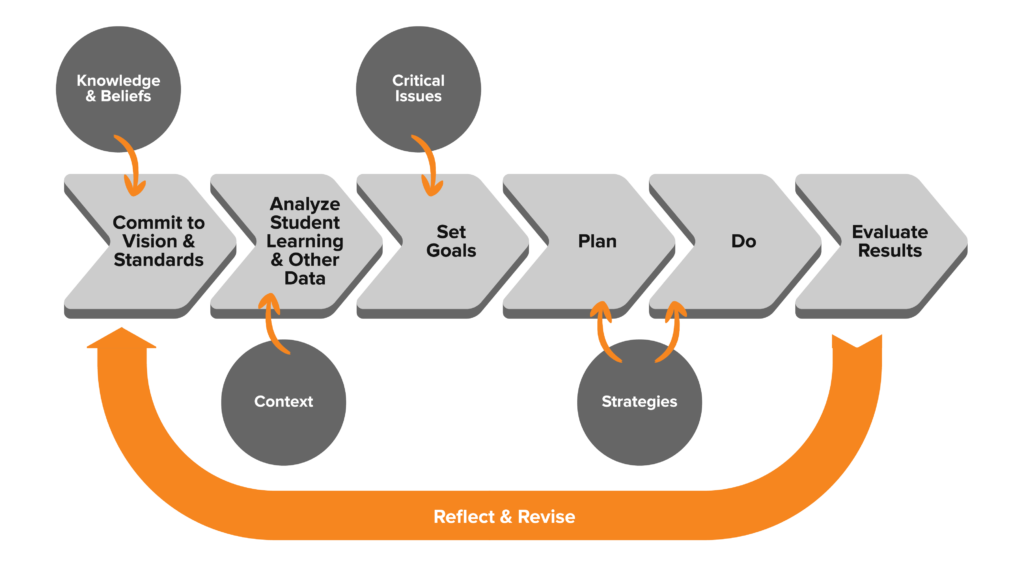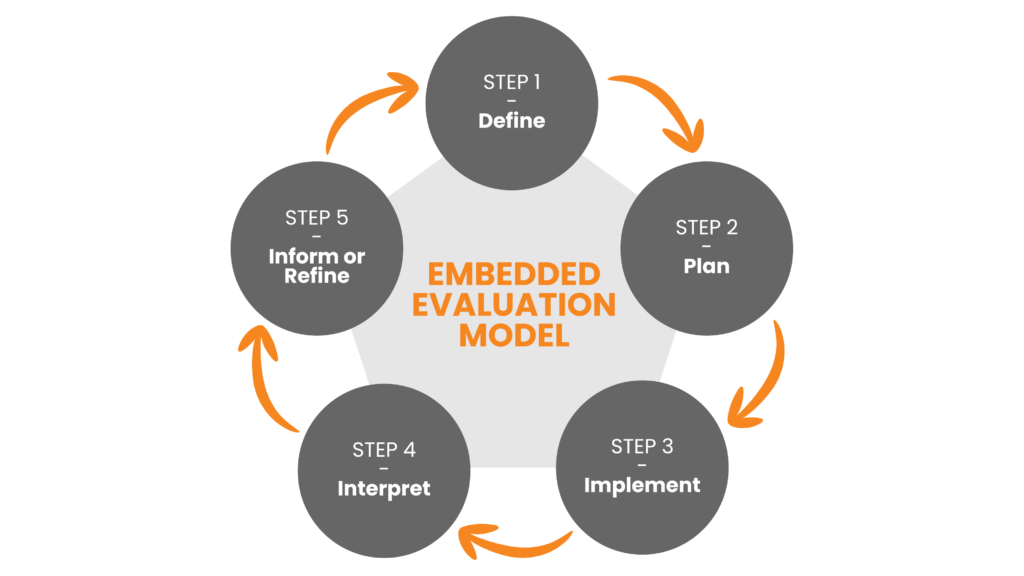In a Learning Forward report on “Why Professional Development Matters”, Mizell (2010) describes professional development (PD) as “the strategy schools and school districts use to ensure that educators continue to strengthen their practice throughout their career.” I like this view of looking at PD as a “strategy” which implies that there is a plan of action towards achieving a goal. When a school’s PD strategy is planned and executed well, that’s when noticeable progress happens.
In this post, I will look at a conventional framework for professional development and explore the distinction between professional development and professional learning. I will also look at an evaluation model for assessing the impact of professional learning.
Professional Development Design Framework
Loucks-Horsley et al. (2010) developed a design framework for professional development which captures the whole process as a planning cycle. The framework consists of six design and implementation process steps depicted by the arrows in Figure 1, and four inputs depicted by the circles.
The framework begins with stakeholders committing to a shared set of vision and standards. This is then followed by collecting and analyzing student learning in order to set relevant goals that address critical issues. Next, strategies are planned to address the critical issues and key actions for implementation are carried out. Finally the results and evaluated and key learnings serve as input for reflection and revision for continuous improvement.
According to Loucks-Horsley et al. (2010), this framework serves as an ideal guide for planners but they also leave room for planners to navigate changes and “hone in on the parts of the framework that best serve their purpose.” For instance, a PD planner in the age of remote learning may want to consider the critical issues in student learning and reflect upon current practices in order to determine new PD strategies or refine current practices.

Source: Loucks-Horsley et al. (2010)
From Professional Development to Professional Learning
While teacher professional development (PD) matters, the impact of PD on changes to teaching and student outcomes remains debatable. Some mandatory training has been repeated year in year out using decades-old resources and does not contribute to teaching and learning changes in the long-term term. Instead, Scherff (2018) suggests that professional learning experiences yield better and more sustainable results.
There is a distinction between professional development and professional learning. Scherff (2018) describes professional development as something “which ‘happens to’ teachers, and is often associated with one-time workshops, seminars, or lectures, and is typically a one-size-fits-all approach.” Professional learning, on the other hand, “is typically interactive, sustained, and customized to teachers’ needs.” Scherff further asserts that professional learning is what will lead to system-wide changes in student outcomes as it not only encourages practical application in teachers’ unique teaching contexts but also empowers teachers to take ownership of their own learning.
Scherff (2018) adds that high-quality professional learning:
- is tied to specific content and standards;
- incorporates active learning;
- is job-embedded;
- is collaborative;
- provides models;
- includes coaching;
- is sustained and continuous; and
- is aligned with school goals, standards and assessments, and other professional learning activities (Archibald, Coggshall, Croft, & Goe, 2011; Darling-Hammond, Hyler, & Gardner, 2017; Labone, & Long, 2016, as cited in Scherff, 2018).
| STEP 1 – Make all professional learning decisions only in serious consultation with teachers and principals. Ensure at least 50% teacher representation on school and district teams that are responsible for every stage of decision making from planning and data analysis to design, implementation, and evaluation. |
| STEP 2 – Rethink organization of the school day so that educators have time to meet regularly to collaborate with colleagues to improve teaching and learning. |
| STEP 3 – Involve and support teachers in analyzing data and identifying teaching and learning challenges. |
| STEP 4 – Establish learning communities where educators solve problems of practice and share responsibility for colleague and student success. |
| STEP 5 – Give teachers choices regarding their professional learning, including who they work with and where they focus their learning. |
| STEP 6 – Ensure that professional learning is for the purpose of continuous growth, not evaluation. |
| STEP 7 – Resist the temptation to “scale up” or mandate a particular form of professional learning without thoroughly examining the context in which it will be implemented. Understand that learners must want to improve their practice and see how the learning opportunity will help them do so. |
Source: Calvert (2016, p.6)
Professional Learning Evaluation Model
Schools often invest a lot of money in professional learning for teachers without a verifiable way to determine if the investments yield the desired impact and outcomes. Having a method for evaluating professional learning not only provides decision-makers with insights on what went well with the programs and what can be improved but also helps justify the investment into professional learning and inform future decisions to continue or terminate programs (Breslow & Bock, 2020).
According to Mertens & Wilson (2012), as cited in Breslow & Bock( 2020), there are two types of evaluations which are often used together to collect information about the implementation process as well as the outcomes achieved.
- Formative evaluation – often conducted during the implementation of a program to enable adjustments and enhancements mid-course.
- Summative evaluation – is more focused on assessing short- and long-term outcomes and is used to gain information about program effectiveness.
The US Department of Education presents a five-step framework for evaluation which is iterative, dynamic, and mimics the continuous improvement process.
- Define – define the purpose of the evaluation
- Plan – determine evaluation design and questions to be answered
- Implement – examines how data should be collected and analyzed
- Interpret – how results should be used and communicated
- Inform or Refine – use information collected to make decisions

Source: U.S. Department of Education, Office of Elementary and Secondary Education, School Support and Rural Programs (2014) as cited in Breslow & Bock( 2020).
Guskey (2000) outlined five critical levels of information for consideration when evaluating professional learning:
- Level 1: Participants’ reactions – Did participants feel the professional learning was useful?
- Level 2: Participants’ learning – Did they acquire the intended knowledge and skills?
- Level 3: Organization support and change – Was professional learning implementation advocated, facilitated, and supported at the school?
- Level 4: Participants’ use of new knowledge and skills – Did participants effectively apply the new knowledge and skills?
- Level 5: Student learning outcomes – What was the impact on students?
| Evaluation Level | What questions are addressed? (Represents a sampling of questions) | How will the information be gathered (Represents a sampling of tools) | What is measured or assessed? | How will the information be used? |
|---|---|---|---|---|
| Participants’ Reaction (Guskey Level 1) |
Did participants find it useful? Was their time well spent? |
Questionnaires, focus groups, interviews, learning logs |
Initial satisfaction with experience | To improve program design and delivery |
| Participants’ Learning (Guskey Level 2) |
Did participants acquire the intended skills and knowledge? | Simulations and demonstrations, paper pencil activities, case study analysis | New knowledge and skill of participants | To improve program content, format, and organization |
| Organizational Support and Change (Guskey Level 3) |
Was implementation advocated, facilitated, and supported? Was the support public and overt? | District and school records, questionnaires, structured interviews with key stakeholders | The organization’s advocacy, support accommodations, facilitation, and recognition | To document and improve organizational support and/or to inform future change efforts |
| Participants’ Use of New Knowledge and Skill (Guskey Level 4) |
Did participants effectively apply the new knowledge and skills? | Questionnaires, interviews, reflections, portfolios, direct observations, video | Degree and quality of implementation | To document and improve the implementation of the program |
| Student Learning Outcomes (Guskey Level 5) |
What was the impact on students? | School/student records, questionnaires, interviews | Student learning outcomes: cognitive, affective, psychomotor | To focus and improve all aspects of program design, implementation, and follow-up; and/or to demonstrate the overall impact of professional development |
Source: Guskey (2000, pp. 79-81)
Refer to this link for the full Professional Learning Evaluation Toolkit which includes a process guide for developing an evaluation plan, activities, tools, and other resources for monitoring professional learning initiatives.
References
- Breslow, N., & Bock, G. (2020, December). Evaluating professional learning – a tool for schools and districts. REL Northeast & Islands. Retrieved February 2, 2022, from https://ies.ed.gov/ncee/edlabs/regions/northeast/pdf/NE_5.3.5_Evaluation_PD_Brief_12-22-20_accessible.pdf
- Calvert, L. (2016). Moving from Compliance to Agency – What Teachers Need to Make Professional Learning Work. Learning Forward and NCTAF. Retrieved February 2, 2022, from https://learningforward.org/wp-content/uploads/2017/08/moving-from-compliance-to-agency.pdf
- Guskey, T. R. (2000). Evaluating professional development (pp. 79–81). Corwin Press.
- Loucks-Horsley, S., Stiles, K. E., Mundry, S., Love, N., & Hewson, P. W. (2010). Designing professional development for teachers of science and mathematics. Corwin Press.
- Mizell, H. (2010). Why Professional Development Matters. Learning Forward. Retrieved February 2, 2022, from https://learningforward.org/wp-content/uploads/2017/08/professional-development-matters.pdf
- Scherff, L. (2018, January 4). Distinguishing Professional Learning from Professional Development. Institute of Education Sciences (IES) Home Page, a part of the U.S. Department of Education. Retrieved February 2, 2022, from https://ies.ed.gov/ncee/edlabs/regions/pacific/blogs/blog2_DistinguishingProfLearning.asp


I like that you and Katie both used Guskey’s model for your posts this week! It’s interesting to see how you have both applied similar research to your questions. I’m wondering if based on Guskey’s model, how you would decide that the PD was successful. In my experience, sometimes new ideas are introduced and not implemented because they don’t fit in with someone’s philosophy or style of teaching, maybe there’s a lack of time or resources to support the implementation, or other reasons. So, if someone doesn’t get to level 5 and sits at level 1 or 2, is that PD session considered a success?
Informative post! I see we both spent some time with Guskey’s model for our research which is great. In the framework you’ve highlighted, I was particularly struck by the first step: stakeholders committing to a shared set of vision and standards. This seems like an obvious first-step but is so frequently overlooked. Making sure stakeholders have a say in the goal of professional learning will ensure that it is relevant and applicable in authentic settings. I was also intrigued by Scherff’s distinction between professional development and professional learning. It makes sense that semi-annual compliance training, for example, might be categorized as PD (a necessary evil that probably isn’t going away any time soon), vs. a professional learning endeavor which takes on all the rich implications of a true learning experience.